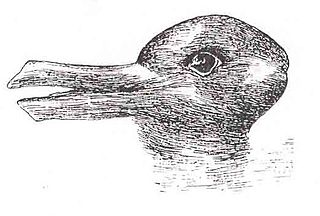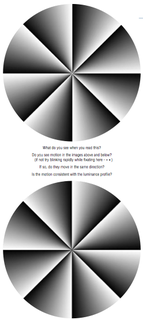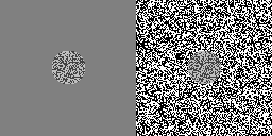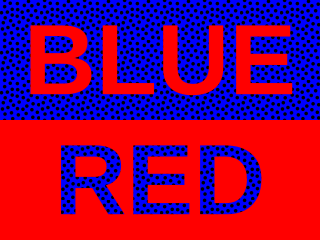
An optical illusion is an illusion caused by the visual system and characterized by a visual percept that arguably appears to differ from reality. Illusions come in a wide variety; their categorization is difficult because the underlying cause is often not clear but a classification proposed by Richard Gregory is useful as an orientation. According to that, there are three main classes: physical, physiological, and cognitive illusions, and in each class there are four kinds: Ambiguities, distortions, paradoxes, and fictions. A classical example for a physical distortion would be the apparent bending of a stick half immerged in water; an example for a physiological paradox is the motion aftereffect. An example for a physiological fiction is an afterimage. Three typical cognitive distortions are the Ponzo, Poggendorff, and Müller-Lyer illusion. Physical illusions are caused by the physical environment, e.g. by the optical properties of water. Physiological illusions arise in the eye or the visual pathway, e.g. from the effects of excessive stimulation of a specific receptor type. Cognitive visual illusions are the result of unconscious inferences and are perhaps those most widely known.
A tactile illusion is an illusion that affects the sense of touch. Some tactile illusions require active touch, whereas others can be evoked passively. In recent years, a growing interest among perceptual researchers has led to the discovery of new tactile illusions and to the celebration of tactile illusions in the popular science press. Some tactile illusions are analogous to visual and auditory illusions, suggesting that these sensory systems may process information in similar ways; other tactile illusions don't have obvious visual or auditory analogs.

In photography, shutter speed or exposure time is the length of time when the film or digital sensor inside the camera is exposed to light, also when a camera's shutter is open when taking a photograph. The amount of light that reaches the film or image sensor is proportional to the exposure time. 1⁄500 of a second will let half as much light in as 1⁄250.

An afterimage is an image that continues to appear in the eyes after a period of exposure to the original image. An afterimage may be a normal phenomenon or may be pathological (palinopsia). Illusory palinopsia may be a pathological exaggeration of physiological afterimages. Afterimages occur because photochemical activity in the retina continues even when the eyes are no longer experiencing the original stimulus.
The Pulfrich effect is a psychophysical percept wherein lateral motion of an object in the field of view is interpreted by the visual cortex as having a depth component, due to a relative difference in signal timings between the two eyes.
Beta movement is an optical illusion whereby viewing a rapidly changing series of static images creates the illusion of a smoothly flowing scene. This occurs when the frame rate is greater than 10 to 12 separate images per second. The illusion of motion caused by animation and film relies on beta movement. The static images do not physically change but give the appearance of motion because of being rapidly changed faster than the eye can see.

A stroboscope also known as a strobe, is an instrument used to make a cyclically moving object appear to be slow-moving, or stationary. It consists of either a rotating disk with slots or holes or a lamp such as a flashtube which produces brief repetitive flashes of light. Usually the rate of the stroboscope is adjustable to different frequencies. When a rotating or vibrating object is observed with the stroboscope at its vibration frequency, it appears stationary. Thus stroboscopes are also used to measure frequency.

Ambiguous images or reversible figures are visual forms which exploit graphical similarities and other properties of visual system interpretation between two or more distinct image forms. These are famous for inducing the phenomenon of multistable perception. Multistable perception is the occurrence of an image being able to provide multiple, although stable, perceptions. Classic examples of this are the rabbit-duck and the Rubin vase. Ambiguous images are important to the field of psychology because they are often research tools used in experiments. There is varying evidence on whether ambiguous images can be represented mentally, but a majority of research has theorized that they cannot be properly represented mentally. The rabbit-duck image seems to be one of the earliest of this type; first published in Fliegende Blätter, a German humor magazine ; the My Wife and My Mother-in-Law drawing, which dates from a German postcard of 1888, is another early example.

The term illusory motion, also known as motion illusion, is an optical illusion in which a static image appears to be moving due to the cognitive effects of interacting color contrasts, object shapes, and position. Apparent motion is the most common type of illusory motion and is perceived when images are displayed in succession at a specific frame rate such as in a movie.
The science of photography refers to the use of science, such as chemistry and physics, in all aspects of photography. This applies to the camera, its lenses, physical operation of the camera, electronic camera internals, and the process of developing film in order to take and develop pictures properly.
The Abney effect describes the perceived hue shift that occurs when white light is added to a monochromatic light source.

The peripheral drift illusion (PDI) refers to a motion illusion generated by the presentation of a sawtooth luminance grating in the visual periphery. This illusion was first described by Faubert and Herbert (1999), although a similar effect called the "escalator illusion" was reported by Fraser and Wilcox (1979). A variant of the PDI was created by Kitaoka Akiyoshi and Ashida (2003) who took the continuous sawtooth luminance change, and reversed the intermediate greys. Kitaoka has created numerous variants of the PDI, and one called "rotating snakes" has become very popular. The latter demonstration has kindled great interest in the PDI.

The Chubb illusion is an optical illusion or error in visual perception in which the apparent contrast of an object varies substantially to most viewers depending on its relative contrast to the field on which it is displayed. These visual illusions are of particular interest to researchers because they may provide valuable insights in regard to the workings of human visual systems.

Chromostereopsis is a visual illusion whereby the impression of depth is conveyed in two-dimensional color images, usually of red-blue or red-green colors, but can also be perceived with red-grey or blue-grey images. Such illusions have been reported for over a century and have generally been attributed to some form of chromatic aberration.

Impossible colors are supposed colors that do not appear in ordinary visual functioning. Non-physical colors are those notionally resulting from combinations of retinal outputs which cannot arise in normal vision. Chimerical colors are perceived, typically transiently, through contrast effects.
An empirical theory of perception is a kind of explanation for how percepts arise. These theories hold that sensory systems incorporate information about the statistical properties of the natural world into their design and relate incoming stimuli to this information, rather than analyzing sensory stimulation into its components or features.

The watercolor illusion, also referred to as the water-color effect, is an optical illusion in which a white area takes on a pale tint of a thin, bright, intensely colored polygon surrounding it if the coloured polygon is itself surrounded by a thin, darker border. The inner and outer borders of watercolor illusion objects often are of complementary colours. The watercolor illusion is best when the inner and outer contours have chromaticities in opposite directions in color space. The most common complementary pair is orange and purple. The watercolor illusion is dependent on the combination of luminance and color contrast of the contour lines in order to have the color spreading effect occur.

Neon color spreading is an optical illusion in the category of transparency effects, characterized by fluid borders between the edges of a colored object and the background in the presence of black lines. The illusion was first documented in 1971 and was eventually rediscovered in 1975 by Van Tuijl.

A phantom contour is a type of illusory contour. Most illusory contours are seen in still images, such as the Kanizsa triangle and the Ehrenstein illusion. A phantom contour, however, is perceived in the presence of moving or flickering images with contrast reversal. The rapid, continuous alternation between opposing, but correlated, adjacent images creates the perception of a contour that is not physically present in the still images. Quaid et al. have also authored a PhD thesis on the phantom contour illusion and it's spatiotemporal limits which maps out limits and proposes mechanisms for its perception centering around magnocellularly driven visual area MT.
A color appearance model (CAM) is a mathematical model that seeks to describe the perceptual aspects of human color vision, i.e. viewing conditions under which the appearance of a color does not tally with the corresponding physical measurement of the stimulus source.














